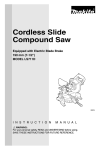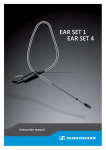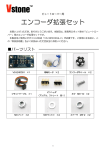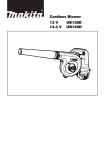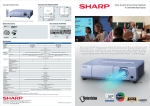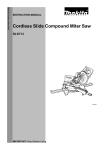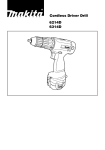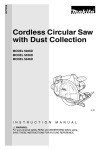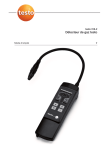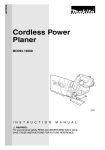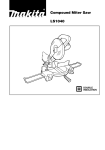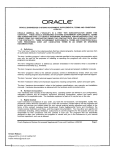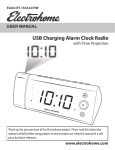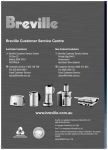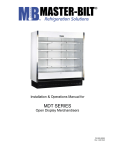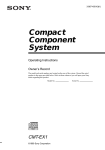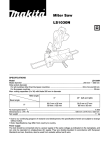Download Cordless Slide Compound Saw
Transcript
ENGLISH Cordless Slide Compound Saw Equipped with Electric Brake 190 mm MODEL LS711D 002214 I N S T R U C T I O N M A N U A L WARNING: For your personal safety, READ and UNDERSTAND before using. SAVE THESE INSTRUCTIONS FOR FUTURE REFERENCE. SPECIFICATIONS Blade diameter : ............................................................................................. 180 - 190 mm Hole (arbor) diameter : .............................................................................................. 20 mm Max. Miter angle : ....................................................................................Left 47°, Right 57° Max. Bevel angle : ....................................................................................................Left 45° Max. Cutting capacities (H x W) with blade 190 mm in daiameter. Miter angle Bevel angle 0° 45° (left) 0° 50 mm x 182 mm 35 mm x 182 mm 45° (left and right) 50 mm x 127 mm 35 mm x 127 mm (Note) The max. Cutting capacities may vary according to workpiece, blade and/or charging condition. No load speed : ..................................................................................................2,000 min.-1 Dimensions (L x W x H) : ...................................................... 550 mm x 430 mm x 454 mm Net weight : ............................................................................................................... 10.5 kg • Manufacturer reserves the right to change specifications without notice. • Specifications may differ from country to country. Intended use The tool is intended for accurate straight and miter cutting in wood. SYMBOLS END303-1 The following show the symbols used for the tool. Be sure that you understand their meaning before use. ................. Indoor use only ................ Read instruction manual. .................. DOUBLE INSULATION .......... Ready to charge ............. Charging 2 .............Charging complete ......................Delay charge (too hot battery) .........Deffective battery ................. Do not short batteries. ....... Always recycle batteries. ................ Do not discard batteries into garbage can or the like. ................To avoid injury from flying debris, keep holding the saw head down, after making cuts, until the blade has come to a complete stop. ...............For your safety, remove the chips, small pieces, etc. from the table top before operation. NOTE: The recycling method may differ from country to country, or state (province) to state (province). Consult with your nearest Makita Authorized Service Center or Distributor. SAFETY INSTRUCTIONS ENA002-1 WARNING: When using battery operated tools basic safety precautions, including the following, should be followed to reduce the risk of fire, leaking batteries and personal injury: Read these instructions before operating this product and save these instructions. For safe operation: 1. Keep work area clean. Cluttered areas and benches invite injuries. 2. Consider the work environment. Do not expose the tool to rain. Keep work area well lit. Do not use tools in the presence of flammable liquids or gases. 3. Keep children away. Do not let visitors touch the tool. Keep visitors away from work area. 4. Store batteries or idle tools. When not in use, tools and batteries should be stored separately in a dry, high or locked up place, out of reach of children. Ensure that battery terminals cannot be shorted by other metal parts such as screws, nails, etc. 5. Do not force the tool. It will do the job better and safer at the rate for which it was intended. 6. Use the right tool. Do not force small tools or attachments to do the job of a heavy duty tools. Do not use tools for purposes not intended. 7. Dress properly. Do not wear loose clothing or jewellery, they can be caught in moving parts. Non-skid footwear is recommended when working outdoors. Wear protecting hair covering to contain long hair. 8. Use protective equipment. Use safety glasses and if the cutting operation is dusty, a face or dust mask. 9. Connect dust extraction equipment. If devices are provided for the connection of 3 dust extraction and collection ensure these are connected and properly used. 10. Do not abuse the supply cord ( if fitted ). Never carry the tool by the cord or yank it to disconnect from the socket. Keep the cord away from heat, oil and sharp edges. 11. Secure the work. Use clamps or a vice to hold the work. It is safer than using your hand and it frees both hands to operate the tool. 12. Do not over-reach. Keep proper footing and balance at all times. 13. Maintain tools with care. Keep cutting tools sharp and clean for better and safer performance. Follow instructions for lubrication and changing accessories. Inspect tool cords periodically and if damaged have repaired by an authorized service facility. 14. Disconnect tools. Where the design permits, disconnect the tool from its battery pack when not in use, before servicing and when changing accessories such as blades, bits and cutters. 15. Remove adjusting keys and wrenches. Form the habit of checking to see that keys and adjusting wrenches are removed from the tool before turning it on. 16. Avoid unintentional starting. Do not carry the tool with a finger on the switch. 17. Stay alert. Watch what you are doing. Use common sense. Do not operate the tool when you are tired. 18. Check damaged parts. Before further use of the tool, a guard or other part that is damaged should be carefully checked to determine that it will operate properly and perform its intended function. Check for alignment of moving parts, free running of moving parts, breakage of parts, mounting and any other condition that may affect its operation. A guard or other part that is damaged should be properly repaired or replaced by an authorized service facility unless otherwise indicated in this instruction manual. Have 4 defective switches replaced by an authorized service facility. Do not use the tool if the switch does not turn it on and off. 19. Warning. The use of any accessory or attachment, other than recommended in this instruction manual or the catalog, may present a risk of personal injury. Ensure that the battery pack is correct for the tool. Ensure that the outside surface of battery pack or tool is clean and dry before plugging into charger. Ensure that batteries are charged using the correct charger recommended by the manufacturer. Incorrect use may result in a risk of electric shock, overheating or leakage of corrosive liquid from the battery. 20. Have your tool repaired by a qualified person. This tool is constructed in accordance with the relevant safety requirements. Repairs should only be carried out by qualified persons using original spare parts, otherwise this may result in considerable danger to the user. 21. Disposal of battery. Ensure battery is disposed of safety as instructed by the manufacturer. ADDITIONAL SAFETY RULES FOR TOOL ENB035-2 1. Be aware that this tool is always in an operating condition, because it does not have to be plugged into an electrical outlet. 14. Be careful not to damage the arbor, flanges (especially the installing surface) or bolt. Damage to these parts could result in blade breakage. 2. Wear eye protection. 15. Make sure that the turn base is properly secured so it will not move during operation. 3. Keep hands out of path of saw blade. Avoid contact with any coasting blade. It can still cause severe injury. 4. Do not operate saw without guards in place. Check blade guard for proper closing before each use. Do not operate saw if blade guard does not move freely and close instantly. Never clamp or tie the blade guard into the open position. 5. Do not perform any operation freehand. The workpiece must be secured firmly against the turn base and guide fence with the vise during all operations. Never use your hand to secure the workpiece. 6. Never reach around saw blade. 7. Turn off tool and wait for saw blade to stop before moving workpiece or changing settings. 8. Remove battery from tool before changing blade or servicing. 9. Always secure all moving portions before carrying the tool. 10. Stopper pin which locks the cutter head down is for carrying and storage purposes only and not for any cutting operations. 11. Don’t use the tool in the presence of flammable liquids or gases. 12. Check the blade carefully for cracks or damage before operation. Replace cracked or damaged blade immediately. 13. Use only flanges specified for this tool. 16. For your safety, remove the chips, small pieces, etc. from the table top before operation. 17. Avoid cutting nails. Inspect for and remove all nails from the workpiece before operation. 18. Make sure the shaft lock is released before the switch is turned on. 19. Be sure that the blade does not contact the turn base in the lowest position. 20. Hold the handle firmly. Be aware that the saw moves up or down slightly during start-up and stopping. 21. Make sure the blade is not contacting the workpiece before the switch is turned on. 22. Before using the tool on an actual workpiece, let it run for a while. Watch for vibration or wobbling that could indicate poor installation or a poorly balanced blade. 23. Wait until the blade attains full speed before cutting. 24. Stop operation immediately if you notice anything abnormal. 25. Do not attempt to lock the trigger in the on position. 26. Be alert at all times, especially during repetitive, monotonous operations. Don’t be lulled into a false sense of security. Blades are extremely unforgiving. 27. Always use accessories recommended in this manual. Use of improper accessories 5 such as abrasive wheels may cause an injury. 28. Do not use the saw to cut other than wood or similar materials. 30. Select saw blades in relation to the material to be cut. 31. Take care when slotting. 32. Replace the kerf board when worm. 29. Connect miter saws to a dust collecting device when sawing. SAVE THESE INSTRUCTIONS IMPORTANT SAFETY INSTRUCTIONS FOR CHARGER & BATTERY CARTRIDGE 1. SAVE THESE INSTRUCTIONS- This manual contains important safety and operating instructions for battery charger. 2. Before using battery charger, read all instructions and cautionary markings on (1) battery charger, (2) battery, and (3) product using battery. 3. CAUTION - To reduce risk of injury, charge only MAKITA type rechargeable batteries. Other types of batteries may burst causing personal injury and damage. 4. Do not expose charger to rain or snow. 5. Use of an attachment not recommended or sold by the battery charger manufacturer may result in a risk of fire, electric shock, or injury to persons. 6. To reduce risk of damage to electric plug and cord, pull by plug rather than cord when disconnecting charger. 7. Make sure cord is located so that it will not be stepped on, tripped over, or otherwise subjected to damage or stress. 6 ENC001-3 8. Do not operate charger with damaged cord or plug - replace them immediately. 9. Do not operate charger if it has received a sharp blow, been dropped, or otherwise damaged in any way; take it to a qualified serviceman. 10. Do not disassemble charger or battery cartridge; take it to a qualified serviceman when service or repair is required. Incorrect reassembly may result in a risk of electric shock or fire. 11. To reduce risk of electric shock, unplug charger from outlet before attempting any maintenance or cleaning. Turning off controls will not reduce this risk. 12. The battery charger is not intended for use by young children or infirm persons without supervision. 13. Young children should be supervised to ensure that they do not play with the battery charger. 14. If operating time has become excessively shorter, stop operating immediately. It may result in a risk of overheating, possible burns and even an explosion. 15. If electrolyte gets into your eyes, rinse them out with clear water and seek medical attention right away. It may result in loss of your eyesight. ADDITIONAL SAFETY RULES FOR CHARGER & BATTERY CARTRIDGE 1. Do not charge battery cartridge when temperature is BELOW 10°C (50°F) or ABOVE 40°C (104°F). 2. Do not attempt to use a step-up transformer, an engine generator or DC power receptacle. 3. Do not allow anything to cover or clog the charger vents. 4. Always cover the battery terminals with the battery cover when the battery cartridge is not used. 5. Do not short the battery cartridge: (1) Do not touch the terminals with any conductive material. (2) Avoid storing battery cartridge in a container with other metal objects such as nails, coins, etc. (3) Do not expose battery cartridge to water or rain. A battery short can cause a large current flow, overheating, possible burns and even a breakdown. 6. Do not store the tool and battery cartridge in locations where the temperature may reach or exceed 50°C (122°F). 7. Do not incinerate the battery cartridge even if it is severely damaged or is completely worn out. The battery cartridge can explode in a fire. 8. Be careful not to drop, shake or strike battery. 9. Do not charge inside a box or container of any kind. The battery must be placed in a well ventilated area during charging. 7 INSTALLATION 002193 Bench mounting When the tool is shipped, the handle is locked in the lowered position by the stopper pin. Release the stopper pin by lowering the handle slightly and pulling the stopper pin. 1 1. Stopper Pin 002194 This tool should be bolted with two bolts to a level and stable surface using the bolt holes provided in the tool’s base. This will help prevent tipping and possible injury. 1 1. Bolt FUNCTIONAL DESCRIPTION • 002240 1 2 Installing or removing battery cartridge • Always switch off the tool before insertion or removal of the battery cartridge. • To remove the battery cartridge, withdraw it from the tool while pressing the buttons on both sides of the cartridge. • To insert the battery cartridge, align the tongue on the battery cartridge with the groove in the housing and slip it into place. Always insert it all the way until it locks in place with a little click. If not, it may accidentally fall out of the tool, causing injury to you or someone around you. • Do not use force when inserting the battery cartridge. If the cartridge does not slide in easily, it is not being inserted correctly. 1. Battery cartridge 2. Button 8 CAUTION: Always be sure that the tool is switched off and the battery cartridge is removed before adjusting or checking function on the tool. 004513 2 3 1 1. Battery charger 2. Battery cartridge 3. Charging light Charging 1. Plug the battery charger into the proper AC voltage source. The charging light will flash in green color. 2. Insert the battery cartridge so that the plus and minus terminals on the battery cartridge are on the same sides as their respective markings on the charger. Insert the cartridge fully into the port so that it rests on the charger port floor. 3. When the battery cartridge is inserted, the charging light color will change from green to red and charging will begin. The charging light will remain lit steadily during charging. 4. When the charging light color changes from red to green, the charging cycle is complete. 5. If you leave the battery cartridge in the charger after the charging cycle is complete, the charger will switch into its “trickle charge (maintenance charge)” mode. 6. After charging, unplug the charger from the power source. 7. Refer to the table below for the charging time. 003267 Battery type 1822 1833 1834 1835 Capacity (Ah) 2.0 2.2 2.6 3.0 Number of cells 15 15 15 15 Charging time Appprox. 45min. Appprox. 50min. Appprox. 60min. Appprox. 70min. NOTE: • The battery charger is for charging Makita battery cartridge. Never use it for other purposes or for other manufacturer’s batteries. • When you charge a new battery cartridge or a battery cartridge which has not been used for a long period of time, it may not accept a full charge. This is a normal condition and does not indicate a problem. You can recharge the battery cartridge fully after discharging it completely and recharging a couple of times. • If you charge a battery cartridge from a just operated tool or a battery cartridge which has been left in a location exposed to direct sunlight or heat for a long time, the charging light may flash in red color. If this occurs, wait for a while. Charging will begin after the battery cartridge cools. The battery cartridge will cool 9 faster if you remove the battery cartridge from the battery charger. • If the charging light flashes alternately in green and red color, charging is not possible. The terminals on the charger or battery cartridge are clogged with dust or the battery cartridge is worn out or damaged. Trickle charge (Maintenance charge) If you leave the battery cartridge in the charger to prevent spontaneous discharging after full charge, the charger will switch into its “trickle charge (maintenance charge)” mode and keep the battery cartridge fresh and fully charged. Tips for maintaining maximum battery life 1. Charge the battery cartridge before completely discharged. Always stop tool operation and charge the battery cartridge when you notice less tool power. 2. Never recharge a fully charged battery cartridge. Overcharging shortens the battery service life. 3. Charge the battery cartridge with room temperature at 10°C - 40°C (50°F - 104°F). Let a hot battery cartridge cool down before charging it. 4. Charge the Nickel Metal Hydride battery cartridge when you do not use it for more than six months. 002245 1 1. Blade guard Blade guard When lowering the handle, the blade guard rises automatically. The guard is spring loaded so it returns to its original position when the cut is completed and the handle is raised. NEVER DEFEAT OR REMOVE THE BLADE GUARD OR THE SPRING WHICH ATTACHES TO THE GUARD. In the interest of your personal safety, always maintain the blade guard in good condition. Any irregular operation of the blade guard should be corrected immediately. Check to assure spring loaded return action of guard. NEVER USE THE TOOL IF THE BLADE GUARD OR SPRING ARE DAMAGED, FAULTY OR REMOVED. DOING SO IS HIGHLY DANGEROUS AND CAN CAUSE SERIOUS PERSONAL INJURY. If the see-through blade guard becomes dirty, or sawdust adheres to it in such a way that the blade is no longer easily visible, remove the battery cartridge and clean the guard 10 carefully with a damp cloth. Do not use solvents or any petroleum-based cleaners on the plastic guard. 1 If the blade guard is especially dirty and vision through the guard is impaired, use the supplied socket wrench to loosen the hex bolt holding the center cover. Loosen the hex bolt by turning it counterclockwise and raise the blade guard and center cover. With the blade guard so positioned, cleaning can be more completely and efficiently accomplished. When cleaning is complete, reverse procedure above and secure bolt. Do not remove spring holding blade guard. If guard becomes discolored through age or UV light exposure, contact a Makita service center for a new guard. DO NOT DEFEAT OR REMOVE GUARD. 002195 Positioning kerf board 001782 1. Blade guard This tool is provided with the kerf boards in the turn base to minimize tearing on the exit side of a cut. The kerf boards are factory adjusted so that the saw blade does not contact the kerf boards. Before use, adjust the kerf boards as follows: 1 2 1. Clamp screw 2. Kerf board 001800 1 2 3 4 1. 2. 3. 4. 5. Saw blade Blade teeth Kerf board Left bevel cut Straight cut 5 First, remove the battery cartridge. Loosen all the screws (2 each on left and right) securing the kerf boards. Re-tighten them only to the extent that the kerf boards can still be easily moved by hand. Lower the handle fully and push in the stopper pin to lock the handle in the lowered position. Loosen the clamp screw which secures the slide poles. Pull the carriage toward you fully. Adjust the kerf boards so that the kerf boards just contact the sides of the blade teeth. Tighten the front screws (do not tighten firmly). Push the carriage toward the guide fence fully and adjust the kerf boards so that the kerf boards just contact the sides of blade teeth. Tighten the rear screws (do not tighten firmly). After adjusting the kerf boards, release the stopper pin and raise the handle. Then tighten all the screws securely. • CAUTION: Before and after changing the bevel angle, always adjust the kerf boards as described above. e 11 002196 1 Maintaining maximum cutting capacity This tool is factory adjusted to provide the maximum cutting capacity for a 190 mm saw blade. When installing a new blade, always check the lower limit position of the blade and if necessary, adjust it as follows: 2 1. Adjusting bolt 2. Guide fence 3. Turn Base 3 001540 With the battery cartridge removed, rotate the blade by hand while holding the handle all the way down to be sure that the blade does not contact any part of the lower base. Re-adjust slightly, if necessary. 2 1 3 1. Top surface ot turn base 2. Periphery of blade 3. Guide fence 002241 1 2 1. Adjusting screw 2. Stopper arm 12 First, remove the battery cartridge. Push the carriage toward the guide fence fully and lower the handle completely. Use the socket wrench to turn the adjusting bolt until the periphery of the blade extends slightly below the top surface of the turn base at the point where the front face of the guide fence meets the top surface of the turn base. • CAUTION: After installing a new blade, always be sure that the blade does not contact any part of the lower base when the handle is lowered completely. Always do this with the battery cartridge removed. Stopper arm The lower limit position of the blade can be easily adjusted with the stopper arm. To adjust it, move the stopper arm in the direction of the arrow as shown in the figure. Adjust the adjusting screw so that the blade stops at the desired position when lowering the handle fully. 002197 1 5 4 1. 2. 3. 4. 5. 2 3 Turn base Miter scale Pointer Grip Lock lever Adjusting the miter angle Loosen the grip by turning counterclockwise. Turn the turn base while pressing down the lock lever. When you have moved the grip to the position where the pointer points to the desired angle on the miter scale, securely tighten the grip clockwise. • • 002198 CAUTION: When turning the turn base, be sure to raise the handle fully. After changing the miter angle, always secure the turn base by tightening the grip firmly. Adjusting the bevel angle To adjust the bevel angle, loosen the lever at the rear of the tool counterclockwise. Push the handle to the left to tilt the saw blade until the pointer points to the desired angle on the bevel scale. Then tighten the lever clockwise firmly to secure the arm. 1 1. Lever • 002199 CAUTION: When tilting the saw blade, be sure to raise the handle fully. • After changing the bevel angle, always secure the arm by tightening the lever clockwise. • When changing bevel angles, be sure to position the kerf boards appropriately as explained in the “Positioning kerf boards” section. 1 3 2 1. Pointer 2. Bevel scale 3. Arm 001811 1 Switch action 2 • 1. Lock-off button 2. Switch trigger • CAUTION: Before inserting the battery cartridge into the tool, always check to see that the switch trigger actuates properly and returns to the “OFF” position when released. When not using the tool, remove the lock-off button and store it in a secure place. This prevents unauthorized operation. 13 • Do not pull the switch trigger hard without pressing in the lock-off button. This can cause switch breakage. To prevent the switch trigger from being accidentally pulled, a lock-off button is provided. To start the tool, press in the lockoff button and pull the switch trigger. Release the switch trigger to stop. WARNING: NEVER use tool without a fully operative switch trigger. Any tool with an inoperative switch is HIGHLY DANGEROUS and must be repaired before further usage. • For your safety, this tool is equipped with a lock-off button which prevents the tool from unintended starting. NEVER use the tool if it runs when you simply pull the switch trigger without pressing the lock-off button. Return tool to a Makita service center for proper repairs BEFORE further usage. • NEVER tape down or defeat purpose and function of lock-off button. • Electric brake This tool is equipped with an electric blade brake. If the tool consistently fails to quickly stop blade after switch trigger release, have tool serviced at a Makita service center. The blade brake system is not a substitute for blade guard. NEVER USE TOOL WITHOUT A FUNCTIONING BLADE GUARD. SERIOUS PERSONAL INJURY CAN RESULT. ASSEMBLY • 002200 3 1. Arm 2. Wrench holder 3. Socket wrench 14 1 2 CAUTION: Always be sure that the tool is switched off and the battery cartridge is removed before carrying out any work on the tool. Socket wrench storage The socket wrench is stored as shown in the figure. When using the socket wrench, pull it out of the wrench holder. After using the socket wrench, return it to the wrench holder. Installing or removing saw blade CAUTION: Always be sure that the tool is switched off and the battery cartridge is removed before installing or removing the blade. • Use only the Makita socket wrench provided to install or remove the blade. Failure to do so may result in overtightening or insufficient tightening of the hex bolt. This could cause an injury. • 002193 Lock the handle in the raised position by pushing in the stopper pin. 002215 To remove the blade, use the socket wrench to loosen the hex bolt holding the center cover by turning it counterclockwise. Raise the blade guard and center cover. 1 1. Stopper Pin 21 4 1. 2. 3. 4. 3 Blade Case Hex bolt Socket wrench Blade guard 002216 2 1 Press the shaft lock to lock the spindle and use the socket wrench to loosen the hex bolt clockwise. Then remove the hex bolt, outer flange and blade. 3 5 4 1. 2. 3. 4. 5. Shaft lock Arrow Blade case Socket wrench Hex bolt 15 003499 1 3 5 1. 2. 3. 4. 5. 2 4 To install the blade, mount it carefully onto the spindle, making sure that the direction of the arrow on the surface of the blade matches the direction of the arrow on the blade case. Install the outer flange and hex bolt, and then use the socket wrench to tighten the hex bolt (left-handed) securely counterclockwise while pressing the shaft lock. Return the blade guard and center cover to its original position. Then tighten the hex bolt clockwise to secure the center cover. Release the handle from the raised position by pulling the stopper pin. Lower the handle to make sure that the blade guard moves properly. Make sure shaft lock has released spindle before making cut. Outer flange Inner flange Spindle Saw blade Hex bolt 001783 2 1. 2. 3. 4. 1 4 3 Arrow Blade case Saw blade Arrow 002217 1 2 1. Dust nozzle 2. Fastener 3. Dust bag 3 Dust bag The use of the dust bag makes cutting operations clean and dust collection easy. To attach the dust bag, fit it onto the dust nozzle. When the dust bag is about half full, remove the dust bag from the tool and pull the fastener out. Empty the dust bag of its contents, tapping it lightly so as to remove particles adhering to the insides which might hamper further collection. NOTE: If you connect a Makita vacuum cleaner to your saw, more efficient and cleaner operations can be performed. Securing workpiece • 16 WARNING: It is extremely important to always secure the workpiece properly and tightly with the vise. Failure to do so can cause the tool to be damaged and/or the workpiece to be destroyed. PERSONAL INJURY MAY ALSO RESULT. Also, after a cutting operation, DO NOT raise the blade until the blade has come to a complete stop. 001549 1 2 • 1. Support 2. Turn base 001806 6 1 2 3 4 7 5 1. 2. 3. 4. 5. 6. 7. Vise arm Vise rod Guide fence Holder Holder assembly Vise knob Screw CAUTION: When cutting long workpieces, use supports that are as high as the top surface level of the turn base. Do not rely solely on the vertical vise and/or horizontal vise to secure the workpiece. Thin material tends to sag. Support workpiece over its entire length to avoid blade pinch and possible KICKBACK. Vertical vise The vertical vise can be installed in two positions on either the left or right side of the guide fence or the holder assembly (optional accessory). Insert the vise rod into the hole in the guide fence or the holder assembly and tighten the screw to secure the vise rod. Position the vise arm according to the thickness and shape of the workpiece and secure the vise arm by tightening the screw. If the screw to secure the vise arm contacts the guide fence, install the screw on the opposite side of vise arm. Make sure that no part of the tool contacts the vise when lowering the handle fully and pulling or pushing the carriage all the way. If some part contacts the vise, re-position the vise. Press the workpiece flat against the guide fence and the turn base. Position the workpiece at the desired cutting position and secure it firmly by tightening the vise knob. CAUTION: • The workpiece must be secured firmly against the turn base and guide fence with the vise during all operations. 17 001807 3 2 1 The horizontal vise can be installed on the left side of the base. By turning the vise knob counterclockwise, the screw is released and the vise shaft can be moved rapidly in and out. By turning the vise knob clockwise, the screw remains secured. To grip the workpiece, turn the vise knob gently clockwise until the projection reaches its topmost position, then fasten securely. If the vise knob is forced in or pulled out while being turned clockwise, the projection may stop at an angle. In this case, turn the vise knob back counterclockwise until the screw is released, before turning again gently clockwise. 4 1. 2. 3. 4. Horizontal vise (optional accessory) Vise knob Projection Vise shaft Base The maximum width of the workpiece which can be secured by the horizontal vise is 120 mm. CAUTION: • Grip the workpiece only when the projection is at the topmost position. Failure to do so may result in insufficient securing of the workpiece. This could cause the workpiece to be thrown, cause damage to the blade or cause the loss of control, which can result in PERSONAL INJURY. 002247 The holders and the holder assembly can be installed on either side as a convenient means of supporting workpieces horizontally. Install them as shown in the figure. Then tighten the screws firmly to secure the holders and the holder assembly. 1 2 1. Holder 2. Holder assembly 002246 2 1 1. Holder assembly 2. Rod 12 18 Holders and holder assembly (optional accessories) When cutting long workpieces, use the holder-rod assembly (optional accessory). It consists of two holder assemblies and two rods 12. CAUTION: Always support long workpieces level with the top surface of the turn base for accurate cuts and to prevent dangerous loss of control of the tool. OPERATION • 002218 CAUTION: Before use, be sure to release the handle from the lowered position by pulling the stopper pin. • Make sure the blade is not contacting the workpiece, etc. before the switch is turned on. • Do not apply excessive pressure on the handle when cutting. Too much force may result in overload of the motor and/or decreased cutting efficiency. Push down handle with only as much force as is necessary for smooth cutting and without significant decrease in blade speed. • Gently press down the handle to perform the cut. If the handle is pressed down with force or if lateral force is applied, the blade will vibrate and leave a mark (saw mark) in the workpiece and the precision of the cut will be impaired. • During a slide cut, gently push the carriage toward the guide fence without stopping. If the carriage movement is stopped during the cut, a mark will be left in the workpiece and the precision of the cut will be impaired. 1. Press cutting (cutting small workpieces) Workpieces up to 50 mm high and 97 mm wide can be cut in the following way. Push the carriage toward the guide fence fully and tighten the clamp screw on the turn base clockwise to secure the carriage. Secure the workpiece with the vise. Switch on the tool without the blade making any contact and wait until the blade attains full speed before lowering. Then gently lower the handle to the fully lowered position to cut the workpiece. When the cut is completed, switch off the tool and WAIT UNTIL THE BLADE HAS COME TO A COMPLETE STOP before returning the blade to its fully elevated position. • CAUTION: Firmly tighten the clamp screw on the turn base clockwise so that the carriage will not move during operation. Insufficient tightening may cause unexpected kickback of the blade. Possible serious PERSONAL INJURY may result. 19 002219 2. Slide (push) cutting (cutting wide workpieces) Loosen the clamp screw on the turn base counterclockwise so that the carriage can slide freely. Secure the workpiece with the vise. Pull the carriage toward you fully. Switch on the tool without the blade making any contact and wait until the blade attains full speed. Press down the handle and PUSH THE CARRIAGE TOWARD THE GUIDE FENCE AND THROUGH THE WORKPIECE. When the cut is completed, switch off the tool and WAIT UNTIL THE BLADE HAS COME TO A COMPLETE STOP before returning the blade to its fully elevated position. • CAUTION: Whenever performing the slide cut, FIRST PULL THE CARRIAGE TOWARD YOU FULLY and press down the handle to the fully lowered position, then PUSH THE CARRIAGE TOWARD THE GUIDE FENCE. NEVER START THE CUT WITH THE CARRIAGE NOT FULLY PULLED TOWARD YOU. If you perform the slide cut without pulling the carriage fully or if you perform the slide cut toward your direction, the blade may kickback unexpectedly with the potential to cause serious PERSONAL INJURY. • Never perform the slide cut with the handle locked in the lowered position by pressing the stopper pin. • Never loosen the clamp screw which secures the carriage while the blade is rotating. This may cause serious injury. 3. Miter cutting Refer to the previously covered “Adjusting the miter angle”. 002220 20 4. Bevel cut Loosen the lever and tilt the saw blade to set the bevel angle (Refer to the previously covered “Adjusting the bevel angle”). Be sure to retighten the lever firmly to secure the selected bevel angle safely. Secure the workpiece with a vise. Make sure the carriage is pulled all the way back toward the operator. Switch on the tool without the blade making any contact and wait until the blade attains full speed. Then gently lower the handle to the fully lowered position while applying pressure in parallel with the blade and PUSH THE CARRIAGE TOWARD THE GUIDE FENCE TO CUT THE WORKPIECE. When the cut is completed, switch off the tool and WAIT UNTIL THE BLADE HAS COME TO A COMPLETE STOP before returning the blade to its fully elevated position. • CAUTION: Always be sure that the blade will move down to bevel direction during a bevel cut. Keep hands out of path of saw blade. • During a bevel cut, it may create a condition whereby the piece cut off will come to rest against the side of the blade. If the blade is raised while the blade is still rotating, this piece may be caught by the blade, causing fragments to be scattered which is dangerous. The blade should be raised ONLY after the blade has come to a complete stop. • When pressing the handle down, apply pressure parallel to the blade. If the pressure is not parallel to the blade during a cut, the angle of the blade might be shifted and the precision of the cut will be impaired. 5. Compound cutting Compound cutting is the process in which a bevel angle is made at the same time in which a miter angle is being cut on a workpiece. Compound cutting can be performed at angle shown in the table. 003400 Miter angle Left and Right 45˚ Right 50˚ Right 55˚ Right 57˚ Battery angle Left 0˚ - 45˚ Left 0˚ - 40˚ Left 0˚ - 30˚ Left 0˚ - 25˚ When performing compound cutting, refer to “Press cutting”, “Slide cutting”, “Miter cutting” and “Bevel cut” explanations. 001846 1 3 1. Set plate 2. Holder 3. Screw 2 6. Cutting repetitive lengths When cutting several pieces of stock to the same length, ranging from 220 mm to 385 mm, use of the set plate (optional accessory) will facilitate more efficient operation. Install the set plate on the holder (optional accessory) as shown in the figure. Align the cutting line on your workpiece with either the left or right side of the groove in the kerf board, and while holding the workpiece from moving, move the set plate flush against the end of the workpiece. Then secure the 21 set plate with the screw. When the set plate is not used, loosen the screw and turn the set plate out of the way. NOTE: • 001563 1 1. Cut grooves with blade 7. Groove cutting A dado type cut can be made by proceeding as follows: Adjust the lower limit position of the blade using the adjusting screw and the stopper arm to limit the cutting depth of the blade. Refer to “Stopper arm” section described on previously. After adjusting the lower limit position of the blade, cut parallel grooves across the width of the workpiece using a slide (push) cut as shown in the figure. Then remove the workpiece material between the grooves with a chisel. Do not attempt to perform this type of cut using wide (thick) blades or with a dado blade. Possible loss of control and injury may result. • 002193 Use of the holder-rod assembly (optional accessory) allows cutting repetitive lengths up to 2,200 mm approximately. CAUTION: Be sure to return the stopper arm to the original position when performing other than groove cutting. Carrying tool Make sure that the battery cartridge is removed. Secure the blade at 0Åã bevel angle and the turn base at right miter angle fully. Secure the slide poles after pulling the carriage toward you fully. Lower the handle fully and lock it in the lowered position by pushing in the stopper pin. 1 1. Stopper Pin 002221 Carry the tool by carrying grip as shown in the figure. If you remove the holders, dust bag, etc., you can carry the tool more easily. • • 22 CAUTION: Always secure all moving portions before carrying the tool. Stopper pin is for carrying and storage purposes only and not for any cutting operations. MAINTENANCE • • CAUTION: Always be sure that the tool is switched off and the battery cartridge is removed before attempting to perform inspection or maintenance. WARNING: Always be sure that the blade is sharp and clean for the best and safest performance. Adjusting the cutting angle This tool is carefully adjusted and aligned at the factory, but rough handling may have affected the alignment. If your tool is not aligned properly, perform the following: 002242 1 2 1. Guide fence 2. Hex bolt 002209 1. Miter angle Push the carriage toward the guide fence and tighten the clamp screw on the turn base to secure the carriage. Loosen the grip which secures the turn base. Turn the turn base so that the pointer points to 0° on the miter scale. Then turn the turn base slightly clockwise and counterclockwise to seat the turn base in the 0° miter notch. (Leave as it is if the pointer does not point to 0°.) Loosen the hex bolts securing the guide fence using the socket wrench. Lower the handle fully and lock it in the lowered position by pushing in the stopper pin. Square the side of the blade with the face of the guide fence using a triangular rule, try-square, etc. Then securely tighten the hex bolts on the guide fence in the order from the right side. 1 1. Triangular rule 23 002210 1 Make sure that the pointer points to 0° on the miter scale. If the pointer does not point to 0°, loosen the screw which secures the pointer and adjust the pointer so that it will point to 0°. 2 3 1. Screw 2. Miter scale 3. Pointer 2. Bevel angle 002858 1 4 2 3 1. 2. 3. 4. Arm holder Arm 0° bevel angle adjusting bolt Lever 001819 1 2 3 1. Triangular rule 2. Saw blade 3. Top surface of turn base 24 (1) 0° bevel angle Push the carriage toward the guide fence and tighten the clamp screw on the turn base to secure the carriage. Lower the handle fully and lock it in the lowered position by pushing in the stopper pin. Loosen the lever at the rear of the tool. Turn the 0° bevel angle adjusting bolt (lower bolt) on the right side of the arm two or three revolutions counterclockwise to tilt the blade to the right. Carefully square the side of the blade with the top surface of the turn base using the triangular rule, try-square, etc. by turning the 0° bevel angle adjusting bolt clockwise. Then tighten the lever securely. Make sure that the pointer on the arm point to 0° on the bevel scale on the arm holder. If it does not point to 0°, loosen the screw which secures the pointer and adjust the pointer so that it will point to 0°. 002211 1 2 3 1. Screw 2. Pointer 3. Bevel scale (2) 45° bevel angle Adjust the 45° bevel angle only after performing 0° bevel angle adjustment. To adjust left 45° bevel angle, loosen the lever and tilt the blade to the left fully. Make sure that the pointer on the arm points to 45° on the bevel scale on the arm holder. If the pointer does not point to 45°, turn the 45° bevel angle adjusting bolt (upper bolt) on the right side of the arm until the pointer points to 45°. 002250 1 1. 45° bevel angle adjusting bolt 001145 Replacing carbon brushes Remove and check the carbon brushes regularly. Replace when they wear down to the limit mark. Keep the carbon brushes clean and free to slip in the holders. Both carbon brushes should be replaced at the same time. Use only identical carbon brushes. 1 1. Limit mark 002222 1 2 1. Screwdriver 2. Brush holder cap Use a screwdriver to remove the brush holder caps. Take out the worn carbon brushes, insert the new ones and secure the brush holder caps. After replacing brushes, insert the battery cartridge into the tool and break in brushes by running tool with no load for about 1 minute. Then check the tool while running and electric brake operation when releasing the switch trigger. If electric brake is not working well, ask your local Makita service center for repair. After use • After use, wipe off chips and dust adhering to the tool with a cloth or the like. Keep the blade guard clean 25 according to the directions in the previously covered section titled “Blade guard”. Lubricate the sliding portions with machine oil to prevent rust. • ACCESSORIES • When storing the tool, pull the carriage toward you fully so that the slide pole is thoroughly inserted into the turn base. CAUTION: These accessories or attachments are recommended for use with your Makita tool specified in this manual. The use of any other accessories or attachments might present a risk of injury to persons. Only use accessory or attachment for its stated purpose. If you need any assistance for more details regarding these accessories, ask your local Makita service center. • Carbide-tipped saw blades Miter saw blades 26 For smooth and precise cutting in various materials. • Vise assembly (Horizontal vise) • Vertical vise • Socket wrench 10 • Holder set • Holder assembly • Holder rod assembly • Set plate • Dust bag • Triangular rule • Lock-off button (2 pcs.) • Various type of Makita genuine batteries and chargers. 27 Makita Corporation 884231C7




























